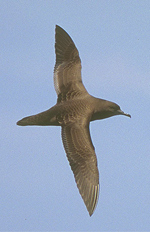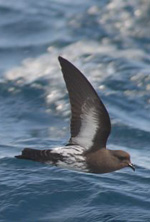| |
 |
 |
Photo top Sooty shearwater,
Copyright © Brian Patteson www.patteson.com
 View full image View full image
Photo above New Zealand storm-petrel,
Copyright © Brent Stephenson 2005 www.eco-vista.com
 View full image View full image |
New Zealand storm-petrel is listed as critically endangered
In a positive change, the New Zealand storm-petrel Oceanites maorianis is now on the 2006 Red List as 'critically endangered' after being 'extinct'.
The New Zealand storm-petrel was rediscovered in 2003 off the Coromandel Peninsula. It was only previously known from three museum specimens, the last of which was collected 150 years ago.
It is New Zealand's fourth reappearance in more than a hundred years of a bird that was thought to be extinct. The takahe Porphyrio mantelli was found in Fiordland in 1948, 20 Campbell Island teal Anas nesiotis were found on tiny Dent Island in 1973, and the Taiko Pterodroma magentae was found in the Chatham Islands in 1978.
There have been several sightings of the NZ storm-petrel off Little Barrier Island in the Hauraki Gulf, and three birds were banded and fitted with transmitters in January 2006 near the Hen and Chickens Islands, but their breeding location has not yet been found. Molecular identification is being done, and samples will be compared with museum specimens and other storm-petrel taxa.
|
| |
Threatened status of two NZ native birds worsens in 2006 global listing
10 December 2006
The sooty shearwater (top left) and the Australasian bittern (right) were the only two New Zealand native birds whose status worsened in the 2006 IUCN Red List of Threatened Species. It has been a better year for New Zealand birds after nine listings deteriorated in 2005.
The Australasian bittern Botaurus poiciloptilus has been moved up from 'vulnerable' to 'endangered'.
It has a small, fragmented range and is believed to be undergoing a decline due to loss and degradation of its wetland habitats.
The sooty shearwater Puffinus griseus also known as the Titi or muttonbird, joins the Red List as 'near threatened' after no previous listing.
While the global population is still large, estimated at 20 million birds, the near threatened status has been given because of a significant reduction in the number of birds.
Sooty shearwaters only breed in the Southern Hemisphere, in New Zealand, Australia, Chile and the Falkland Islands. New Zealand has by far the most birds, with 5 million pairs in 80 breeding colonies – approximately half the world population. They migrate to California, Alaska and Japan to enjoy an endless summer.
Colonies on the Snares islands are estimated to contain 2,750,000 pairs. Between 1969 and 2000 there was a 37 percent decline in the number of burrows, and reduced burrow occupancy on the largest Snares colony. Mainland colonies also show signs of decline. |
| |
 |
| |
About 250,000 young plump muttonbirds which are larger than their parents, are mercilessly pulled from burrows each year worldwide. |
| |
 |
| |
The practice of muttonbirding is a customary right of specific Maori groups, allowed by special legislation in New Zealand. Muttonbirds are sold in retail stores throughout the country. A total of about 250,000 young plump birds which are larger than their parents, are mercilessly pulled from burrows each year worldwide.
This is a small part of the decline of numbers, however, it is inappropriate that muttonbirding continues when the population is dropping significantly.
During the last 20 years the number of sooty shearwaters on the California coast has declined 90 percent.
Researchers have recently used new small tracking devices to follow sooty shearwater migration paths. These small oceanic birds travel 39,000 miles (63,000 kilometres), which is the longest known migration distance of any bird.
The annual assessment of the world's bird species by Birdlife International shows 1,212 threatened with extinction, which together with 788 near threatened species, make a total of 2,000 in trouble. This is more than 20 percent of the global count of 9,775 species.
Eighty-three (39 percent) of New Zealand's 215 living native birds are on the IUCN list, with 9 critically endangered, 21 endangered, 43 vulnerable and 10 near threatened.
The total number of New Zealand birds including subspecies was 273, but with 57 extinctions since human settlement there are 216 living today. |
|



